 |
"Ghost Rocket" photographed over Sweden on July 9, 1946 - probably, in reality, a daylight meteor. While this photo became the most famous image of the supposed guided missiles seen over Scandanavia in the summer of 1946, it is not representative of most of the reports, which actually described low-altitude objects flying on horizontal trajectories and emitting either intermittent flames, like WWII German V-1 cruise missiles, or no trail at all.
Eric Reutersward |
The "Ghost Rockets"
early post-WWII fears of guided missile proliferation
In early 1946, numerous reports of anomalous meteor-like phenomena, as well as seemingly reliable stories of impacts of apparent projectiles of some type (often in lakes) began to reach government and media circles in Scandanavia. Since some of the objects appeared to be missiles, complete with wings, intelligence services began to take note of the apparitions, which had been dubbed "Spook Rockets" or "Ghost Rockets" by the press. As noted below, the Commander in Chief of the Swedish armed forces, Gen Helge Jung, personally witnessed these rocket-like events (on two separate occasions).
The 1946 Ghost Rocket flap represents an intriguing prelude to the "flying saucer" wave of 1947 in that many of the reports do sound remarkably like descriptions of low altitude cruise missiles, but there is virtually no possibility that the Soviet Union either possessed large numbers of highly upgraded V-1s with sophisticated guidance systems (or other winged, long-range, high-speed guided vehicles) at that early date, or that it would have launched them deliberately and repeatedly toward neighboring countries in peacetime even if it did. Straddling the gap between UFO waves and war scares, the Ghost Rockets are one of the earliest examples of Western concerns over the proliferation of guided missile technology.
The Swedish military was given a unique perspective on reports of stray experimental missiles by its experience with them during World War II. Between 1943 and the surrender of Nazi Germany, several V-1 cruise missiles and a V-2 ballistic missile launched on test missions from Peenemunde, the German rocket installation on the Baltic coast, had gone off course and crashed in Swedish territory. These vehicles had been carefully analyzed by Swedish and Allied intelligence teams who were desperate to learn the secrets of the advanced weapons. When the first reports of missile-like luminous phenomena began to come in in early 1946, the same Swedish technical intelligence personnel who had studied the German weapons began to compile reports and look for patterns that might give a clue to the nature of the bizarre objects. By July 1946 enough persuasive reports of low-altitude rocket-like phenomena had been received that the Försvarets Forskningsanstalt (FOA), the Swedish Defense Research Agency, had produced several scale models of the more advanced late-war German missiles and used them to create a photomontage that simulated these missiles in flight. This photo was highly unrealistic -- the V-2 and "A 4" (a misnomer for the A9 winged version of the V-2) were long-range, supersonic high-altitude missiles that would never be seen flying along at sea level like airplanes (although the A9 would be visible in the last phases of its wingborne glide toward its target), and the Wasserfall and Rheintochter R1 were both short-range antiaircraft weapons -- but it might have been intended to provide a sort of "identikit" reference to help establish some credible data regarding the configuration of the reported objects. More importantly, each instance of an apparent Ghost Rocket impact was carefully investigated by military search parties who recovered suspected rocket debris and subjected it to technical analysis. By the end of 1946 the special Ghost Rocket committee of the Swedish Defense Staff had examined some 100 reports of rocket impacts. Of the total of 973 Ghost Rocket reports that had been received by the Defense Staff to November 29, 1946, 225 were considered observations of "real physical objects" and every one had been seen in daylight hours. It was difficult to dismiss the numerous reports as being caused by sightings of ordinary meteors, particularly because some of the objects were seen for tens of seconds and had intermittent flame trails that witnesses compared to the exhaust flames from V-1 cruise missiles.
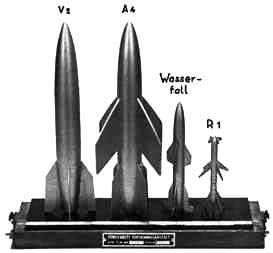
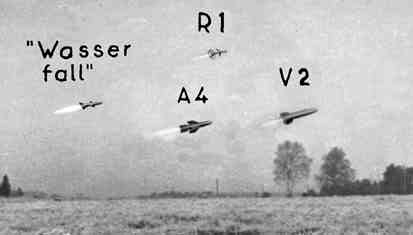
Since it was known that many of the objects had vanished in loud smoky explosions just before striking the ground, and no identifiable hardware was recovered at the sites, the Swedish Ghost Rocket committee began to suspect that the mystery missiles were constructed of some special type of light alloy, possibly magnesium, that would disintegrate or burn up prior to impact. This concept would become a crucial theme of the early post-WWII UFO phenomenon.
See: Dow Chemical and the Scientific Analysis of UFO Debris
Daily newspaper reports in Stockholm, London and the US in July and August 1946 ratcheted up fears that the Soviets were using the missiles - by then reported by several witnesses a day - as instruments in some sort of sinister political intimidation campaign, perhaps as an indirect reply to the US Crossroads nuclear tests in the Pacific on July 1 and July 25 - the first nuclear detonations since Hiroshima and Nagasaki.
Forrestal's Visit
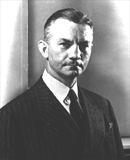 Amid
the growing furor, US Navy Secretary James Forrestal happened to arrive
in Stockholm from Berlin on July 16 for an official visit as part of an
around-the-world trip following his observation of the Crossroads Able
test at Bikini. He had heard about what the Western Allies percieved as
growing Soviet belligerence firsthand from General Lucius Clay in Germany,
and while in Stockholm may have been briefed on what was known about the
suspected missile phenomenon to that point:
Amid
the growing furor, US Navy Secretary James Forrestal happened to arrive
in Stockholm from Berlin on July 16 for an official visit as part of an
around-the-world trip following his observation of the Crossroads Able
test at Bikini. He had heard about what the Western Allies percieved as
growing Soviet belligerence firsthand from General Lucius Clay in Germany,
and while in Stockholm may have been briefed on what was known about the
suspected missile phenomenon to that point:
By the next morning he was playing golf with the charge and by dinnertime was back to the routine, with a formal gathering at which he discussed "the Swedish parliamentary system and the single Department of Defense with a number of eminent Swedes. The Swedes, he learned, 'are obviously uneasy about the proximity and power of Russia' and still, despite their close geographical association, felt that they did not understand the Russians. (The Forrestal Diaries)
The day Forrestal landed in Stockholm the US Military Attache there sent an "Urgent," Top Secret cable to the Pentagon describing what was believed to have occurred to date.
Forrestal departed for London on the 18th. British documents reflect the same sense of confused unease there. On the 16th, British official C. B. Jerram in the British legation in Stockholm cabled the Foreign Office to report that that he had met with Swedish Chief of Combined Intelligence, who confided that the Swedes were worried that the Soviets were behind the phenomenon but were unwilling to publicly so state, stressing '"the vital importance of utmost secrecy and delicacy of the position regarding other nations."' (Public Records Office FO371/56988, quoted in David Clarke and Andy Roberts, Out of the Shadows). Two days later, Squaron Leader Heath of the British Air Ministry and Maj Malone (MI10(a) - artillery and rocket intelligence, British War Office) flew to Stockholm and rushed to a Ghost Rocket briefing at the Swedish Air Ministry. As an indication of the sensitivity of the mission, they reported that they traveled in civilian clothes at Swedish request. Jerram reported in a Secret telegram to the Foreign Office that "Swedes stress need for utmost secrecy and object of Mission is to be confined to selected members of British and Swedish General Staffs only." Jerram added that the sense of the Swedes was that "too many missiles have been observed and described to allow of explanation as meteorites." (FO cables quoted in Clarke and Roberts)
Simultaneously, the Foreign Office issued a comprehensive summary of Ghost Rocket incidents to date which was circulated widely within the British government and even reached Washington, where it became part of a thick classified summary on the phenomenon that was addressed to senior officers of the Army Air Force, including Chief of Staff Carl Spaatz and General Curtis LeMay. The US document contained a map showing certain suspected rocket impact locations and suspected launch sites including Peenemunde, the Aland Islands, and Porkkala, a coastal military base in Finland that had been ceded to the USSR.
On July 19th, as if in mockery of Forrestal's visit to Sweden, one of the most important Ghost Rocket incidents occurred. At about 11:45 AM a gray two-meter rocket-shaped device was seen by multiple witnesses to impact in Lake Kolmjarv in northern Sweden with a large waterspout and explosion. The next day, a Swedish military team under Lt Karl-Gosta Bartoll arrived to search for debris. FOA engineers scanned for radioactivity. A raft was constructed to aid the search, which continued for two weeks. The lake bottom was charted and was found to be disturbed but no hardware or debris was recovered despite a meticulous search. Bartoll reported that "there are many indications that the Kolmjarv object disintegrated itself...the object was probably manufactured in a lightweight material, possibly a kind of magnesium alloy that would disintegrate easily, and not give indications on our instruments." (FOA Report to GR committee, Sept 1946; Svenska Dagbladet 22 July 46 - cited in Lilijgren and Svahn) On July 21, the Swedes reactivated their wartime radar network and began seeking radar confirmation of the visual reports. Amazingly, they did begin to receive anomalous tracks, but their erratic courses simply added to the mystery.
On July 25, the Swedish paper Morgon-Tidningen reported that Swedish military was now requesting public assistance with reports, which were to be sent to the "Air Defense Division, Defense Staff, Stockholm 90....It is possible that the flying bombs which are seen crossing Sweden both with a western direction and in a directly opposite direction, are taking a round trip over the country in order then to return to their place of origin...that they are meteors in every case is a theory which has been rejected without further ado by the defense staff."
On August 14, the New York Times reported that "Under-Secretary of State, Dean Acheson, said today he personally was very much interested in reports of rockets flying over Sweden but that the Swedes had not sought any American advice on the subject." On the 22nd, the Times ran a page two article headlined "Russia Said To Make V-Weapons In Zone":
Berlin, Aug 21 (Reuter) - Russian and German technicians are manufacturing new V weapons in a number of former German arms plants that are working at the full level of their present capacity, well documented and extremely reliable information reaching Berlin from the Soviet occupation zone said today. Evidence has been provided that the Russians are engaged in the production of heavy armaments, special jet aircraft, rocket fuels for V weapons and U-boat and torpedo components in at least ten special factories in several parts of Russian-occupied Germany. Although the Russians do not at present permit Allied investigation of activity inside the closed guarded arms factories in the Russian occupied areas it has been learned that production of components of advanced V weapons is going ahead in such factories as Siemens and Telefunken in Berlin, Nieder-Sachsenwerke at Wolfsleben and the Klein-Bodungen factory, all of which are subsidiaries of the big Bleich-Roeder [sic] concern. In the Magdeburg plant of the Krupps combine the Russians are producing heavy armament equipment that is being shipped into Soviet Russia, it was stated. Special aircraft fuels for jet engines are being produced in the giant Leuna oil plant near Merseburg in Saxony, but production is believed to be on a comparatively small scale, it was added.
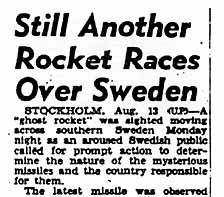 |
This San Francisco Chronicle article is typical of US coverage of the rocket scare in the summer of 1946 click to enlarge |
Factions within the Swedish, British and American intelligence services were deeply concerned with the possibility that the rockets represented Stalin's saber-rattling, although there were equally deep divisions between those who took the reports at face value and those who discounted them. For instance, British technical intelligence expert R V Jones, who had been responsible for evaluating evidence on the WWII German guided missile programs, was highly skeptical that the meteor-like phenomena were actually missiles. On the other hand, other experts - at surprisingly high levels - came to the opposite conclusion.
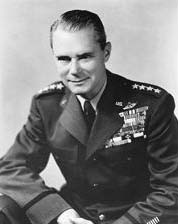 The
following is a US file on the Ghost Rocket phenomenon from August 1946
that includes a top secret memo to President Harry Truman from Army Air
Force Lt General Hoyt Vandenberg, director of the Central Intelligence
Group, stating that the "weight of evidence" pointed to the
Soviet-occupied missile test facility at Peenemunde,
Germany as the origin of the mystery missiles. Vandenberg also passed
along rumors that a Soviet ship in the Baltic was providing radio guidance
correction for the missiles. The CIG speculated that the missiles were
being flown primarily for experimental purposes, aimed for the Gulf of
Bothnia, and did not overfly Swedish territory specifically for intimidation,
although, said Vandenberg, that was probably a secondary consideration.
The
following is a US file on the Ghost Rocket phenomenon from August 1946
that includes a top secret memo to President Harry Truman from Army Air
Force Lt General Hoyt Vandenberg, director of the Central Intelligence
Group, stating that the "weight of evidence" pointed to the
Soviet-occupied missile test facility at Peenemunde,
Germany as the origin of the mystery missiles. Vandenberg also passed
along rumors that a Soviet ship in the Baltic was providing radio guidance
correction for the missiles. The CIG speculated that the missiles were
being flown primarily for experimental purposes, aimed for the Gulf of
Bothnia, and did not overfly Swedish territory specifically for intimidation,
although, said Vandenberg, that was probably a secondary consideration.
Peenemunde, as far as most sources indicate, was at the time still devastated and inactive, apparently far from capable of launching super-sophisticated cruise missiles on provocation overflights of the Scandanavian countries.





Controversy
One of the most interesting aspects of the Ghost Rocket affair is the controversy it generated within the Western military intelligence establishments. While Vandenberg's CIG may have feigned a certain degree of confidence that the objects actually were Soviet experimental missiles, no hard evidence was forthcoming from the Swedes and the US and British technical intelligence representatives were put in the position of secretly competing to wheedle data out of their uncommunicative Swedish counterparts, all against the daily media cacophony about newly reported sightings. The senior US Military Attache in Stockholm at the time, Army Air Force Major General Alfred Kessler, sent a Secret cable to the Pentagon on August 24 that contradicted Vandenberg's CIG report by shrewdly theorizing that the rocket rumors were an "unintentional hoax" on the part of the Swedish military - i.e., that the Swedes, oversensitized to missile reports by their World War II experiences, had frightened themselves into believing that the new objects (which in his opinion really were a variety of mundane events) actually were Soviet missiles, and that this "hoax"
developed naturally but [was] exploited by [Swedish] Defense staff by implication and lack of frankness[,] possibly [in the] interest [of raising the] defense budget and to alert west against east. If rockets are hoax rapidity of deteriorations of west-east relations now puts Swedes in dangerous position in which they could be charged with contributing to breakdown in great power relations... Swedish unofficial release from highly placed members of the Defense Staff or Air Force have stated flatly that rockets with proved origin in Russian territory have been established over Sweden....Further, Defense Staff (source 69) unofficially told SSU officer this legation that Sweden has radar tracks proving existence of rockets over Sweden with USSR origin...If unofficial highly placed sources now hedge and decoy rocket scare, believe hoax theory plausible. If they do not, possibly Sweden will try to ride two horses continuing to contribute to deterioration of great power relations to get Russian Bear off Sweden's neck...but being ready to repudiate unofficial spokesmen and point to clean record if Sweden accused as trouble maker. Hoax theory conceived jointly by this and Naval Attache office....Discrepancy between official denials rocket evidence and unofficial statements (but not proof) that rocket evidence exists points to possibility of hoax. If Swedes have rocket evidence they need not fear accusation as to trouble maker and official denials of evidence are discredit to officialdom without apparent advantage. If Swedes want to tell us about real rockets easiest way would be to use official contacts. Avobe [sic] submitted as worthy of consideration at this time. This office continues to reserve judgment pending receipt of factual evidence, every effort being continued to obtain same.
Sightings spread to other European countries, including Italy, Greece, France, Switzerland, Belgium and the Netherlands, then eventually tapered off in the late summer of 1946.
|
How Did the Soviets React to the Ghost Rocket Furor? Not long after the German surrender in 1945, the Soviets had sent a "Special Technical Commission" (Russian abbreviation OTK) on rocket exploitation to the Eastern zone of Germany under great secrecy to set up a recovery effort. On September 8, 1945, Sergei Korolev flew to Berlin to become deputy head of OTK. Rocket engine designer Glushko followed soon after. The rocket exploitation activity set up by OTK at Bleicherode was named "Institute Rabe." By mid September Helmutt Groettrup arrived at Institute Rabe as the senior former Peenemunde rocket scientist under Soviet control. Groettrup had been a senior deputy in guidance and control group under Ernst Steinhoff (Siddiqi, Challenge To Apollo). The US had already reached many of the German rocket facilities and had retrieved as much equipment as possible prior to Soviet occupation, and most of the top former Nazi rocket technicians had gone over to the Western Allies, but the Russians were able to compile a great deal of documentation and hardware which was to prove priceless to their early post-war rocket development projects. The Soviets were certainly aware that they were being accused by much of the Western press, if not openly by Western governments, of being responsible for the 1946 missile overflights, and did react in their own press to a limited extent. On August 18, the Russians held their largest airshow since WWII at Tushino airfield and unveiled several new jet and rocket-powered aircraft, possibly exacerbating the fears of those in the West who believed the Soviets were behind the Ghost Rockets, as seen by the CIG report issued soon afterward. The August 21 Reuters story that alleged that the V-weapon plants in the Soviet zone of Germany were working at full capacity to build missiles and jet aircraft (and mentioned Bleicherode by name) seems to have particularly annoyed the Russians, and on October 3 the Moscow New Times blasted rumors about production of "mysterious kinds of weapons" supposedly being manufactured in Soviet zone of Germany. The Reuters story was the particular target of the New Times article, which charged that the source of the information in Reuters story were "mythical representatives of the [East German] Socialist Unity Party."
On October 11, British Ambassador to Poland Cavendish Bentinck [Victor Frederick William Cavendish Bentinck, 9th Duke of Portland (1897-1990), wartime chairman of MI6's Joint Intelligence Committee (JIC)] sent a coded cable to the Foreign Office asking that the Peenemunde region be placed under scrutiny, at least as to whether the area actually was closed to non-Soviet personnel.
Did Western inquisitiveness concerning Peenemunde because of the Ghost Rockets raise Soviet worries to the point that retaining the Groettrup team at Institute Rabe in Germany was no longer considered safe? On October 23, just days after Cavendish Bentinck's cable, the Groettrup German rocket team was rounded up by its Soviet hosts at Bleicherode and evacuated from Germany to the USSR in an overnight urgent mission. 20,000 technical experts and workers were taken along soon, along with factories and equipment. Eventually the Nordhausen V-2 production line, rocket engine production and test facilities, guidance and tracking equipment factories, and all rocket-related ancillaries were moved to the USSR.
Some support for the idea that the Ghost Rockets may have played a part in increasing Western nosiness and Soviet vigilance comes from intelligence historian Stephen Dorril. Writing in his book "MI6: Inside the Covert World of Her Majesty's Secret Intelligence Service," Dorril notes that
|
Reconnaissance
Since the Ghost Rockets were never firmly pinned on the Soviets, interest in the phenomenon continued for years. Some sightings and unusual radar trackings were made in early 1947, and by that July the US Navy conducted electronic intelligence (ELINT) ferret flights near Peenemunde as part of Operation PASSIONATE, possibly the earliest post-WWII US reconnaissance mission on the perimeter of the Soviet Union. Ferret squadron VP-26 Det 214, flying modified PB4Y Privateers, reported that it had obtained intercepts of signals from the former German installation which they interpreted as radar emissions and directional guidance beams similar to those used during WWII for certain German missile experiments.
 |
US Navy electronic intelligence "ferret" PB4Y of Squadron VP-26. Note direction-finding antenna above fuselage |
On July 13, 1947, in the wake of a phenomenal outbreak of flying object sightings in the US, these apparent confirmations of Soviet missile activity in the Baltic the previous year leaked to the press, and respected journalists Joseph and Stewart Alsop claimed that it had been "established beyond doubt" that the objects reported over Sweden had actually been versions of the German A9 winged glide missile that had been developed in a joint German/Soviet program.
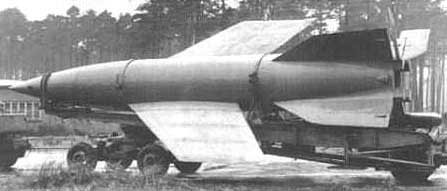 |
A9 prototype (A4b) at Peenemunde circa early 1945 |
The Berlin Crisis the following year provoked more concern about the location and nature of Soviet installations in the Baltic. On August 24, 1948, Col J. E. Mallory, of the USAF Directorate of Intelligence's Requirements Division Reconnaissance Branch, reported that special cameras had been loaned to the Swedish Air Force, which had recently conducted reconnaissance flights over the Eastern Baltic islands of Dago and Osel (Hiiumaa and Saaremaa, adjacent to Estonia), the supposed launch site of some of the mystery missiles. These islands lie roughly 150 miles east of Stockholm and would have been logical sites for launch facilities for V-1-class cruise missiles. Based on comments made in a Top Secret Air Force Intelligence memo dated August 1949, the Swedish reconnaissance missions actually had discovered V-1 (Chelomei 10X - the Soviet V-1 copy) launch sites and associated antiaircraft batteries during the covert missions over these islands.
 |
Map of "Operation Falun" - a secret overflight of Saaremaa Island, conducted by the Swedish Air Force on July 10, 1948, in an effort to locate Soviet missile installations. A single F-51 fighter, modified to carry a US-provided K-22 camera, made the quick intrusion
from Bortom horisonten |
TOP SECRET
DEPARTMENT OF THE AIR FORCE
HEADQUARTERS UNITED STATES AIR FORCE
WASHINGTON 24 August 1948
AFOIR-RC
MEMORANDUM FOR EXECUTIVE, AIR INTEL, REQUIREMENTS DIVISION
SUBJECT: SUPPLEMENT to Daily Activity 24 Aug 1948
1. It has been noted in cable brief that Sweden Armed Force C in C, General Jung, saw an aerial explosion considered to be some form of guided missile originating from Estonian islands, possible Dago or Osel. A point of interest lies in the fact that recent word has been received from our attache in Stockholm of a reconnaissance sortie accomplished over Osel and the stated intention of further aerial reconnaissance there. The Swedish reports have mentioned civilian evacuation on the western coast of the above islands.
2. The Swedish aerial reconnaissance stems from an arrangement which was made with the Directorate of Intelligence for the loan of long focal length cameras to the Swedes.
3. General Jung has a keen interest in the products of reconnaissance in a personal as well as an official way. He has as a personal friend the head of the section of the General Staff of Defense which is charged with covert reconnaissance; General Jung's sister-in-law holds a key position in that section.
4. It is believed that photographs of the area will be received in the near future. (Lt Col Fuller 2376)
/s/ J. E. Mallory
/t/ J. E. MALLORY
Colonel, USAF
Chief, Reconnaissance Branch
Air Intelligence Requirements Div.
Directorate of Intelligence
 |
Soviet Petelyakov Pe-8 bomber carrying Chelomei 10X cruise missile in air-launch test circa 1947 |
US intelligence forces continued to issue reports blaming the Ghost Rockets on Soviet experiments well into 1948. The October issue of the classified, official Pentagon publication Air Intelligence Digest, which featured a photo of Soviet Long Range Air Force Chief Marshal Aleksandr Golovanov on its cover, contained an article titled "Fires in the Sky" which reported that
An increase in number of incidents over Sweden during summer may be connected with Soviet guided missile tests in the Lake Seliger area (57 N. - 33 E.) or along the Baltic coast of Estonia. About 32 launching sites reportedly exist in areas fronting on the Baltic Sea. Swedish sources claim to have confirmed the existence of three such sites. Reocurrence of so-called rocket incidents over Sweden is important in view of the reported move of Peenemunde launching facilities to locations in the USSR. Earlier, the greatest number of incidents in Scandanavia occurred in 1946, when the Peenemunde facilities reportedly were being used in trial launchings of German World War II missiles then being manufactured in the Soviet Zone of Germany. Sightings of rockets over Scandanavia ceased with the reported removal of Peenemunde facilities but began again almost coincidentally with the reported establishment of test facilities in the USSR. Any missiles being test-fired by the Soviets in areas such as the Baltic probably are slightly improved versions of German World War II types, and those which may be under development at installations in the interior regions of the USSR possibly are more advanced types. [Secret]
The German missile engineers under Soviet control had in fact been moved to Lake Seliger by that time...but were the Soviets really responsible for the Ghost Rocket phenomenon? Even assuming that most of the reports were "noise," was there any signal present? While it is not possible that even a sizeable portion of the too-numerous reports could have been missiles, was even one of the overflights or alleged impacts an actual Soviet V-1-class missile that went astray, either after launch from the Peenemunde region, the Estonian islands, or from an airplane over the Baltic? British and US intelligence documents from 1946 make it clear that the Swedish government was actutely sensitive to the problem of angering the Soviets by publicizing such information, and it seems possible that it would have suppressed hard evidence at the time. But would such a coverup have endured for decades?
"What Are Your Reactions?"
Up to this point, the Ghost Rocket affair could be viewed as just an intriguing mystery from the early formative days of the Cold War, when the two sides were growing more and more mistrustful, and the West was unsure of Soviet motives and lacked means of judging the lengths to which Stalin would go to attain them.
But the story takes a turn that warps it out of the realm of "acceptable conventional military history." By 1948, stimulated by the details of the eyewitness accounts of the strange behavior of many of the alleged missiles, another theory was beginning to develop. Swedish intelligence intimated that as time passed it had begun to mull over the possibility that the Ghost Rockets were "interplanetary" vehicles of some type, due to the alleged lack of hardware from missile impacts and the unlikelihood that the Soviets would have conducted extremely risky and apparently purposeless missile overflights of Scandanavia for more than two years. The "interplanetary" theory was conspicuously absent from intelligence comments on the Ghost Rockets in 1946, but the idea would grow and take hold as more and more unusual reports were collected in the ensuing months. It was the birth of a tenacious controversy.
Analysts with a skeptical attitude might view this theory as a way for the Swedish military to squirm out of the corner it had seemingly painted itself into. Based on Sweden's political orientation during WWII, when it had tried to avoid aligning with either Hitler or the Allies, it seems difficult to visualize the Swedish government making strong protests to Stalin in 1946 even if indisputable evidence missile impacts had been obtained. If Sweden had in fact recovered verifiable debris from one or more stray Russian missiles and the government considered this too dangerous to reveal, it may have believed that floating rumors of extraterrestrial origin might have clouded the issue of the magnitude of its concern over more local threats. On the other hand, if no missile evidence existed, the numerous highly unusual reports were still hard to swallow as being caused by mundane phenomena, such as meteors, since many of the objects reportedly did not conform to meteor behavior. If the witness testimony, including that of senior members of the Swedish military, was to be accepted, some other explanation was necessary.
The document cited above demonstrates that the Swedish "interplanetary" theory reenforced similar thinking within US Air Force Intelligence just at the time when Project SIGN's Top Secret "UFO Estimate" was circulating through the American intelligence division. SIGN's "Estimate" apparently attempted to make the same case as the Swedes - that ongoing reports of rocket-like anomalous phenomena were accurate accounts of real vehicles that could not be the products of known technologies.
See: The Chiles-Whitted "Rocketship" Sighting
An additional point might be made. It appears that if some of the Ghost Rocket incidents actually did involve observations of Soviet-launched missiles, a precedent was established very early on in the Cold War era for accidental masking of missile activity as UFO incidents. Much later in the history of Soviet clandestine missile activity, such masking seems to have become a planned policy.
See: The Great Soviet UFO Coverup
Sources
While many UFO histories refer to the Ghost Rockets as a prelude to the 1947 Flying Saucer wave, English-language official documentation on the phenomenon is surprisingly absent from the published record and the rocket scare is essentially ignored by aerospace history. One of the best accounts is "Ghost Rockets and Phantom Aircraft," by Anders Liljegren and Clas Svahn, in Phenomeon: Forty Years of Flying Saucers, John Spencer and Hilary Evans, eds. (Avon, 1988). Thanks to Mr Liljegren for helpful insights on certain issues. His expertise and experience regarding Scandanavian UFO history are unrivaled. Dr David Clarke and Andy Roberts also describe the British reaction to the flap in their book Out of the Shadows.
Special thanks also to Jan Aldrich of Project 1947 and Dr David Clarke for copies of Ghost Rocket-related documents from the US State Department, Central Intelligence Group, Central Intelligence Agency, SSU, US Army Air Force Intelligence, US Navy Intelligence, British Foreign Office, Air Ministry Technical Intelligence Division, Royal Air Force, and other official sources; to Loren Gross for permission to cite his Ghost Rocket monographs; to Swedish friends for information on the 1948 covert overflights and other rare data; and particularly to Dr S. K.







